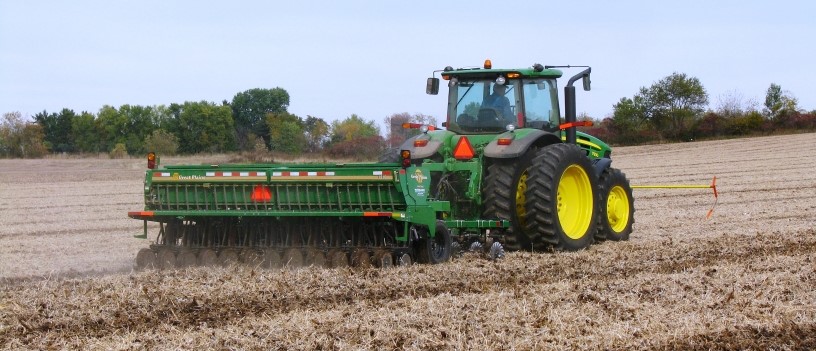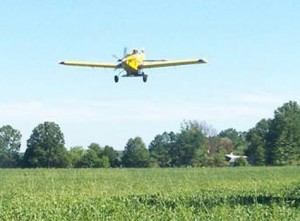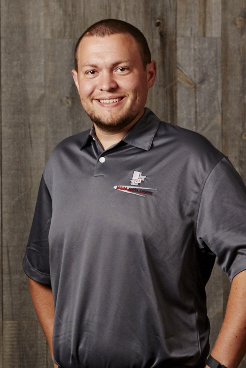ILSOYADVISOR POST
When to Seed Fall Crops
Here in late August 2020, the days are getting shorter and we’ve been waking up to unseasonably cool morning temperatures that remind us fall is around the corner. For an ever-increasing number of fields, there will be a quick turnaround before they get seeded to their next crop.
In traditional crop rotations, still common in Southern Illinois, fall is when next summer’s wheat crops are seeded. It is a common practice across much of Illinois to plant a shorter maturity of soybeans on those fields preselected to be planted to wheat. In my experience, the best stands of wheat are achieved with a grain drill.

When To Plant Wheat?
It is important to check your county’s Hessian Fly Free date, and begin planting wheat acres after the date has passed. The Hessian Fly is an insect that historically has caused a lot of damage to wheat fields. While modern varieties carry some resistance genes to the damage these pests do, wheat planted after the fly free date is also less susseptible to Septoria brown spot, wheat streak mosaic virus and barley yellow dwarf virus. Don’t feel like you have to panic. Remember that once harvest is completed, there should be time for other field operations such as fertilizer application, fixing harvest ruts from last fall and possibly tillage.
Cover Crop Planting
Another type of crop quickly growing in acres across the Midwest is cover crop seeding. A cover crop is a plant species or mixture of plant species grown between cash crops for a purpose other than grain harvest.
If not planted to wheat, corn typically follows soybeans as the next cash crop planted. Common cover crops planted ahead of corn are oats, oil seed/tillage radishes, crimson clover and hairy vetch. Oats and radishes are a common mix of winter killed cover crops. They capture excess nutrients from your soil, put down deep roots to alleviate compaction and aid in water infiltration.
 Crimson clover and hairy vetch are both legumes which overwinter and fix nitrogen for next year’s corn crop. All overwintering species need to be seeded in an early window so they can get enough fall growth to overwinter and to produce benefits for the soil. The tight window to get this accomplished in the fall usually has farmers applying seed via airplane rather than grian dirll. Here in Macoupin county where I live, the recommended seeding dates for these cover crops are after August 1st and before September 15th.
Crimson clover and hairy vetch are both legumes which overwinter and fix nitrogen for next year’s corn crop. All overwintering species need to be seeded in an early window so they can get enough fall growth to overwinter and to produce benefits for the soil. The tight window to get this accomplished in the fall usually has farmers applying seed via airplane rather than grian dirll. Here in Macoupin county where I live, the recommended seeding dates for these cover crops are after August 1st and before September 15th.
Seeding with an airplane takes a bit of coordination, timing and the right soil moisture for good stands. I keep a careful eye on my fields during late summer and check fields every day when the pods are filled out at the top of the plant (R6 stage). There will be a day that you notice the fields don’t have quite as deep green color as they did the day before. When this occurs, I release my fields to be spread.
There is usually a day or two lag for the applicator to get there. By the time cover crop seed is flown, there is a start of a yellow cast to the field. It is usually two to three weeks from that yellow cast to full leaf drop. The canopy of yellow leaves helps hold humidity and moisture down on the ground from morning dews or any passing shower. Even better for your germinating seed is when the full canopy of yellow leaves drops off the plants and lays over the top of your seeds and seedlings.
I’ve had very good luck timing my applications like this as long as you aren’t in a drought. As the soybean canopy opens up, your small cover crop seedlings will very rapidly begin growing. I recommend harvesting those soybean fields as timely as possible. In case of inclimate weather during harvest, I’ve even had cover crops get a slight “haricut” by the combine sickle. This doesn’t cause any issues, though. The green vegetation went right though my combine, and the cover crops exploded in growth with the full sunlight hitting the ground after soybean harvest.
The more fall growth cover crops get, the more benefits they return to you. I hope you find my tips helpful this fall and that you have a safe and happy harvest.





Comments
Add new comment